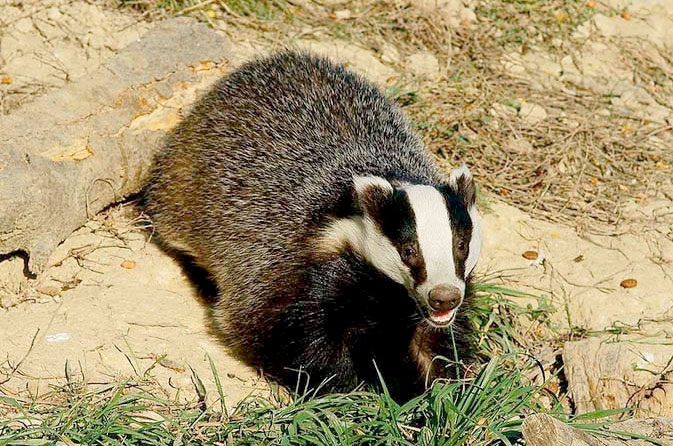
Vaccination schemes are being demonstrated as a 'practical, cost-effective option' in dealing with bovine tuberculosis, an animal trust is claiming in light of the recent go-ahead for the second year of badger culls.
Ahead of the Government’s badger culls starting in Somerset and Gloucestershire for the second year, The Wildlife Trusts are calling for a nationally coordinated, and funded, badger vaccination strategy to be delivered in conjunction with measures to tackle the disease in cattle.
The conservation organisation’s badger vaccination report, published this week (19 August) outlines the progress of 10 badger vaccination schemes over the past three years. These schemes have seen vaccinations given on Wildlife Trust nature reserves and privately-owned land, in partnership with farmers, vets and other landowners.
The report includes lessons learned from activity so far, as well as a detailed description of the vaccination process including costs (£380 per dose administered/£998 per km2). Cost of delivery is variable and depends on the size, nature and accessibility of the sites involved. First year costs are generally much higher than ongoing costs due to training, certification and capital equipment requirements. Vaccination across large areas of land or adjoining land units will reduce delivery costs if equipment and resources can be shared, and is expected to provide greater disease control benefits within badger populations.
The report states that, although offering the most effective approach to dealing with bovine TB in badgers, vaccination represents only one element of an overarching strategy to reduce prevalence of the disease in cattle, and should therefore be delivered alongside a comprehensive package of cattle measures.
The Wildlife Trusts believe a coordinated programme of badger vaccination can make a viable contribution to the Government’s bTB eradication strategy by reducing transmission of bTB between badgers and between badgers and cattle. Vaccination reduces the severity of the disease, the shedding of bacteria from infected individual badgers and therefore the disease’s prevalence in badger populations.
Paul Wilkinson, Head of Living Landscape for The Wildlife Trusts, said: “We have been working on the issue of bovine TB (bTB) and its links to badgers for many years. We work very closely with the farming community, as well as being significant farmers and landowners in our own right, and are very conscious of the hardship that bTB causes. Culling badgers is not the answer; it won’t significantly reduce disease prevalence in cattle and could even make the situation worse, due to the perturbation effect where the disease is spread by badgers moving between setts post-cull.
“It is vital that we find the right mechanisms to control this disease and the emphasis of all our efforts should be to find an effective, long-term solution.
“We firmly believe that vaccination offers the most effective, long-term and sustainable approach to bTB in badgers, and there is a strong scientific evidence base supporting this view. However, addressing the disease in badgers can at best make a limited contribution to the eradication of bTB in cattle.
“Cattle to cattle transmission represents the most important route of disease spread, so it is vital that the main focus of the Government’s strategy to eradicate bTB remains on cattle measures, as this is where the most significant disease-control gains will be made.”
Debbie Tann, CEO of Hampshire & Isle of Wight Wildlife Trust said: “We are classified as being in an “edge” area in Hampshire and so our strategy locally has been to focus our badger vaccinations on sites that pose the highest potential risk. Thanks to the generosity of our members we raised £45,000 through an appeal and begun vaccinating on four sites this year.”
The government agency said the culls will begin to prevent the spread of bovine tuberculosis (bTB). Operations in these areas where TB is rife will be carried out under the existing licences which allow six weeks of culling to take place every year between 1 June and 31 January. Start dates for culling activity will be decided by the licensed companies.
Under the terms of the authorisation letters, licensees have been set a minimum number of badgers to be removed – these are 615 in Gloucestershire and 316 in Somerset. A maximum number of badgers has also been set (1091 in Gloucestershire, 785 in Somerset) to safeguard the local populations.
NFU President Meurig Raymond said: “Bovine TB continues to devastate farming family businesses across large parts of the country and it is essential that we do everything we can to control and eradicate it. Last year more than 32,000 cattle were slaughtered because of this disease and more than 4,700 additional farming families saw their businesses affected by it.
“In areas where the disease is endemic, like the South West, action must be taken to control it in badgers if we are to stop reinfection occurring and have any chance of wiping it out. This has been acknowledged by the Government and is reflected in its 25-year TB eradication strategy.
“Both cull companies have worked closely with Defra and Natural England to ensure that the recommendations made by the Independent Expert Panel to improve the delivery of operations following last year’s culls have been implemented.
“The Chief Vet has said culling over a four-year period in both pilot areas will have an impact on disease control and we remain confident that these pilots will help to deliver a reduction of TB in cattle. It is vital that they are allowed to be successfully completed so they can deliver the maximum benefits.”
